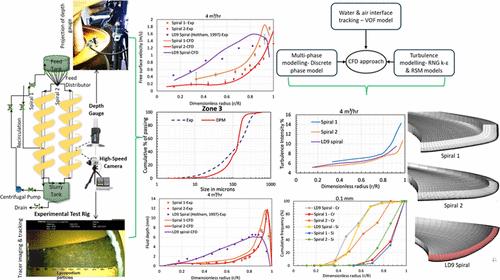当前位置:
X-MOL 学术
›
Ind. Eng. Chem. Res.
›
论文详情
Our official English website, www.x-mol.net, welcomes your feedback! (Note: you will need to create a separate account there.)
Comparative Studies of Experimental and Numerical Investigations of Fluid Flow and Particle Separation of High-Gravity Spiral Concentrators
Industrial & Engineering Chemistry Research ( IF 3.8 ) Pub Date : 2024-06-25 , DOI: 10.1021/acs.iecr.4c00769 Prudhvinath Reddy Ankireddy 1 , Purushotham Sudikondala 1 , Narasimha Mangadoddy 1 , Sunil Kumar Tripathy 2 , Rama Murthy Yanamandra 3
Industrial & Engineering Chemistry Research ( IF 3.8 ) Pub Date : 2024-06-25 , DOI: 10.1021/acs.iecr.4c00769 Prudhvinath Reddy Ankireddy 1 , Purushotham Sudikondala 1 , Narasimha Mangadoddy 1 , Sunil Kumar Tripathy 2 , Rama Murthy Yanamandra 3
Affiliation

|
Particle stratification in spiral concentrators occurs due to the combined action of gravitational and centrifugal forces. Spiral flows have a free surface, shallow depths, and a transition from laminar to turbulent behavior. The current study investigates the comparisons of the flow field and bicomponent particle separation in high-gravity spirals with conventional coal spirals, often termed low-gravity spirals. A sensitive digital flow depth gauge is utilized to measure the fluid depth across the spiral trough. A high-speed motion camera is utilized to measure the free surface velocity via a tracer tracking approach. This flow visualization technique incorporates lycopodium powder as tracer particles to capture the free surface flow field on a dark background. Further, the two-phase flow is modeled for these designs by utilizing the volume of fluid model (VOF), incorporating the Reynolds stress model and RNG k–ε turbulence models. Comparisons were made on the flow patterns between high-gravity and low-gravity spirals, which differ in their trough profiles. High-gravity spiral concentrators exhibit greater depths, free surface velocities, secondary circulations, and turbulence intensities toward the outer edges compared to low-gravity spirals. The discrete phase model (DPM) is employed for particle tracking, thereby understanding particle segregation radially along the spiral trough. Performance data on bicomponent particle separation is presented to compare the separation effectiveness of high- and low-gravity spirals. Heavy mineral ore, such as chromite, is computationally tested with high- and low-gravity spirals, and it was found that low-gravity spirals are ineffective in achieving satisfactory particle separation. Also, the results demonstrate that each spiral has its own distinct size range for effectively separating particles. The DPM model predictions were validated against in-house experiments conducted with monocomponent silica material, and a reasonable match was found with the experimental data.
中文翻译:

高重力螺旋选矿机流体流动和颗粒分离的实验与数值研究的比较研究
螺旋选矿机中的颗粒分层是由于重力和离心力的共同作用而发生的。螺旋流具有自由表面、浅深度以及从层流到湍流行为的过渡。目前的研究调查了高重力螺旋与传统煤螺旋(通常称为低重力螺旋)的流场和双组分颗粒分离的比较。利用灵敏的数字流量深度计来测量穿过螺旋槽的流体深度。利用高速运动相机通过示踪剂跟踪方法测量自由表面速度。这种流动可视化技术采用石松粉作为示踪颗粒,以捕获深色背景上的自由表面流场。此外,通过利用流体体积模型 (VOF),结合雷诺应力模型和 RNG k-ε 湍流模型,对这些设计的两相流进行建模。对高重力和低重力螺旋的流型进行了比较,它们的槽型不同。与低重力螺旋选矿机相比,高重力螺旋选矿机具有更大的深度、自由表面速度、二次循环以及朝向外边缘的湍流强度。采用离散相模型(DPM)进行颗粒跟踪,从而了解颗粒沿螺旋槽径向分离的情况。提供双组分颗粒分离的性能数据,以比较高重力和低重力螺旋的分离效果。重矿物矿石,例如铬铁矿,用高重力和低重力螺旋进行了计算测试,结果发现低重力螺旋不能有效地实现令人满意的颗粒分离。 此外,结果表明,每个螺旋都有自己独特的尺寸范围,可以有效分离颗粒。 DPM 模型预测根据使用单组分二氧化硅材料进行的内部实验进行了验证,并发现与实验数据的合理匹配。
更新日期:2024-06-25
中文翻译:

高重力螺旋选矿机流体流动和颗粒分离的实验与数值研究的比较研究
螺旋选矿机中的颗粒分层是由于重力和离心力的共同作用而发生的。螺旋流具有自由表面、浅深度以及从层流到湍流行为的过渡。目前的研究调查了高重力螺旋与传统煤螺旋(通常称为低重力螺旋)的流场和双组分颗粒分离的比较。利用灵敏的数字流量深度计来测量穿过螺旋槽的流体深度。利用高速运动相机通过示踪剂跟踪方法测量自由表面速度。这种流动可视化技术采用石松粉作为示踪颗粒,以捕获深色背景上的自由表面流场。此外,通过利用流体体积模型 (VOF),结合雷诺应力模型和 RNG k-ε 湍流模型,对这些设计的两相流进行建模。对高重力和低重力螺旋的流型进行了比较,它们的槽型不同。与低重力螺旋选矿机相比,高重力螺旋选矿机具有更大的深度、自由表面速度、二次循环以及朝向外边缘的湍流强度。采用离散相模型(DPM)进行颗粒跟踪,从而了解颗粒沿螺旋槽径向分离的情况。提供双组分颗粒分离的性能数据,以比较高重力和低重力螺旋的分离效果。重矿物矿石,例如铬铁矿,用高重力和低重力螺旋进行了计算测试,结果发现低重力螺旋不能有效地实现令人满意的颗粒分离。 此外,结果表明,每个螺旋都有自己独特的尺寸范围,可以有效分离颗粒。 DPM 模型预测根据使用单组分二氧化硅材料进行的内部实验进行了验证,并发现与实验数据的合理匹配。











































 京公网安备 11010802027423号
京公网安备 11010802027423号